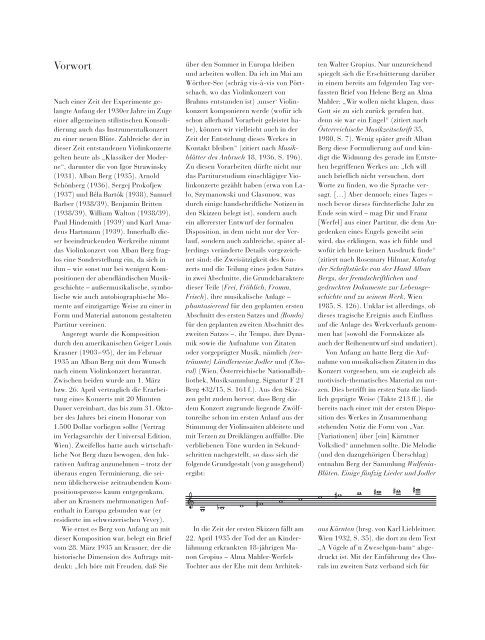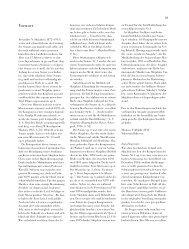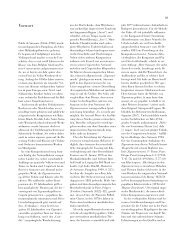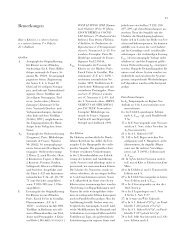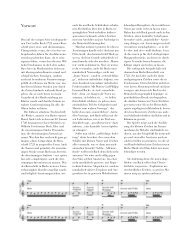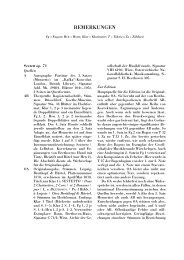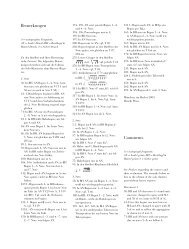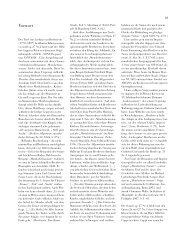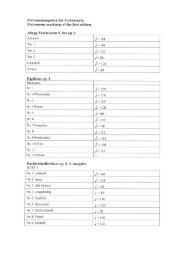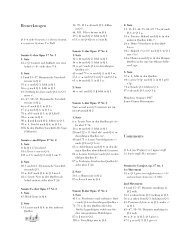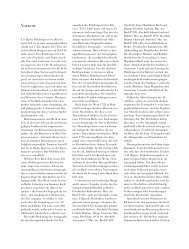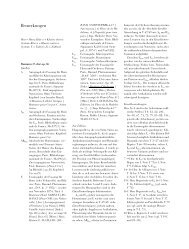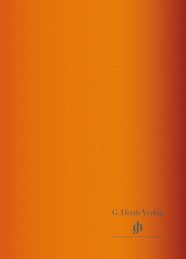Vorwort (PDF, 360 KB) - Henle Verlag
Vorwort (PDF, 360 KB) - Henle Verlag
Vorwort (PDF, 360 KB) - Henle Verlag
You also want an ePaper? Increase the reach of your titles
YUMPU automatically turns print PDFs into web optimized ePapers that Google loves.
IV<br />
<strong>Vorwort</strong><br />
Nach einer Zeit der Experimente gelangte<br />
Anfang der 1930er Jahre im Zuge<br />
einer allgemeinen stilistischen Konsolidierung<br />
auch das Instrumentalkonzert<br />
zu einer neuen Blüte. Zahlreiche der in<br />
dieser Zeit entstandenen Violinkonzerte<br />
gelten heute als „Klassiker der Moderne“,<br />
darunter die von Igor Strawinsky<br />
(1931), Alban Berg (1935), Arnold<br />
Schönberg (1936), Sergej Prokofjew<br />
(1937) und Béla Bartók (1938), Samuel<br />
Barber (1938/39), Benjamin Britten<br />
(1938/39), William Walton (1938/39),<br />
Paul Hindemith (1939) und Karl Amadeus<br />
Hartmann (1939). Innerhalb dieser<br />
beeindruckenden Werkreihe nimmt<br />
das Violinkonzert von Alban Berg fraglos<br />
eine Sonderstellung ein, da sich in<br />
ihm – wie sonst nur bei wenigen Kompositionen<br />
der abendländischen Musikgeschichte<br />
– außermusikalische, symbolische<br />
wie auch autobiographische Momente<br />
auf einzigartige Weise zu einer in<br />
Form und Material autonom gestalteten<br />
Partitur vereinen.<br />
Angeregt wurde die Komposition<br />
durch den amerikanischen Geiger Louis<br />
Krasner (1903–95), der im Februar<br />
1935 an Alban Berg mit dem Wunsch<br />
nach einem Violinkonzert herantrat.<br />
Zwischen beiden wurde am 1. März<br />
bzw. 26. April vertraglich die Erarbeitung<br />
eines Konzerts mit 20 Minuten<br />
Dauer vereinbart, das bis zum 31. Oktober<br />
des Jahres bei einem Honorar von<br />
1.500 Dollar vorliegen sollte (Vertrag<br />
im <strong>Verlag</strong>sarchiv der Universal Edition,<br />
Wien). Zweifellos hatte auch wirtschaftliche<br />
Not Berg dazu bewogen, den lukrativen<br />
Auftrag anzunehmen – trotz der<br />
überaus engen Terminierung, die seinem<br />
üblicherweise zeitraubenden Kompositionsprozess<br />
kaum entgegenkam,<br />
aber an Krasners mehrmonatigen Aufenthalt<br />
in Europa gebunden war (er<br />
residierte im schweizerischen Vevey).<br />
Wie ernst es Berg von Anfang an mit<br />
dieser Komposition war, belegt ein Brief<br />
vom 28. März 1935 an Krasner, der die<br />
historische Dimension des Auftrags mitdenkt:<br />
„Ich höre mit Freuden, daß Sie<br />
über den Sommer in Europa bleiben<br />
und arbeiten wollen. Da ich im Mai am<br />
Wörther-See (schräg vis-à-vis von Pörtschach,<br />
wo das Violinkonzert von<br />
Brahms entstanden ist) ‚unser‘ Violinkonzert<br />
komponieren werde (wofür ich<br />
schon allerhand Vorarbeit geleistet habe),<br />
können wir vielleicht auch in der<br />
Zeit der Entstehung dieses Werkes in<br />
Kontakt bleiben“ (zitiert nach Musikblätter<br />
des Anbruch 18, 1936, S. 196).<br />
Zu diesen Vorarbeiten dürfte nicht nur<br />
das Partiturstudium einschlägiger Violinkonzerte<br />
gezählt haben (etwa von Lalo,<br />
Szymanowski und Glasunow, was<br />
durch einige handschriftliche Notizen in<br />
den Skizzen belegt ist), sondern auch<br />
ein allererster Entwurf der formalen<br />
Disposition, in dem nicht nur der Verlauf,<br />
sondern auch zahlreiche, später allerdings<br />
veränderte Details vorgezeichnet<br />
sind: die Zweisätzigkeit des Konzerts<br />
und die Teilung eines jeden Satzes<br />
in zwei Abschnitte, die Grundcharaktere<br />
dieser Teile (Frei, Fröhlich, Fromm,<br />
Frisch), ihre musikalische Anlage –<br />
phantasierend für den geplanten ersten<br />
Abschnitt des ersten Satzes und (Rondo)<br />
für den geplanten zweiten Abschnitt des<br />
zweiten Satzes –, ihr Tempo, ihre Dynamik<br />
sowie die Aufnahme von Zitaten<br />
oder vorgeprägter Musik, nämlich (verträumte)<br />
Ländlerweise Jodler und (Choral)<br />
(Wien, Österreichische Nationalbibliothek,<br />
Musiksammlung, Signatur F 21<br />
Berg 432/15, S. 161 f.). Aus den Skizzen<br />
geht zudem hervor, dass Berg die<br />
dem Konzert zugrunde liegende Zwölftonreihe<br />
schon im ersten Anlauf aus der<br />
Stimmung der Violinsaiten ableitete und<br />
mit Terzen zu Dreiklängen auffüllte. Die<br />
verbliebenen Töne wurden in Sekundschritten<br />
nachgestellt, so dass sich die<br />
folgende Grundgestalt (von g ausgehend)<br />
ergibt:<br />
In die Zeit der ersten Skizzen fällt am<br />
22. April 1935 der Tod der an Kinderlähmung<br />
erkrankten 18-jährigen Manon<br />
Gropius – Alma Mahler-Werfels<br />
Tochter aus der Ehe mit dem Architekten<br />
Walter Gropius. Nur unzureichend<br />
spiegelt sich die Erschütterung darüber<br />
in einem bereits am folgenden Tag verfassten<br />
Brief von Helene Berg an Alma<br />
Mahler: „Wir wollen nicht klagen, dass<br />
Gott sie zu sich zurück gerufen hat,<br />
denn sie war ein Engel“ (zitiert nach<br />
Österreichische Musikzeitschrift 35,<br />
1980, S. 7). Wenig später greift Alban<br />
Berg diese Formulierung auf und kündigt<br />
die Widmung des gerade im Entstehen<br />
begriffenen Werkes an: „Ich will<br />
auch brieflich nicht versuchen, dort<br />
Worte zu finden, wo die Sprache versagt.<br />
[…] Aber dennoch: eines Tages –<br />
noch bevor dieses fürchterliche Jahr zu<br />
Ende sein wird – mag Dir und Franz<br />
[Werfel] aus einer Partitur, die dem Angedenken<br />
eines Engels geweiht sein<br />
wird, das erklingen, was ich fühle und<br />
wofür ich heute keinen Ausdruck finde“<br />
(zitiert nach Rosemary Hilmar, Katalog<br />
der Schriftstücke von der Hand Alban<br />
Bergs, der fremdschriftlichen und<br />
gedruckten Dokumente zur Lebensgeschichte<br />
und zu seinem Werk, Wien<br />
1985, S. 126). Unklar ist allerdings, ob<br />
dieses tragische Ereignis auch Einfluss<br />
auf die Anlage des Werkverlaufs genommen<br />
hat (sowohl die Formskizze als<br />
auch der Reihenentwurf sind undatiert).<br />
Von Anfang an hatte Berg die Aufnahme<br />
von musikalischen Zitaten in das<br />
Konzert vorgesehen, um sie zugleich als<br />
motivisch-thematisches Material zu nutzen.<br />
Dies betrifft im ersten Satz die ländlich<br />
geprägte Weise (Takte 213 ff.), die<br />
bereits nach einer mit der ersten Disposition<br />
des Werkes in Zusammenhang<br />
stehenden Notiz die Form von „Var.<br />
[Variationen] über [ein] Kärntner<br />
Volkslied“ annehmen sollte. Die Melodie<br />
(und den dazugehörigen Überschlag)<br />
entnahm Berg der Sammlung Wulfenia-<br />
Blüten. Einige fünfzig Lieder und Jodler<br />
&<br />
w bw<br />
w Ì w w w w Ì w w Ì w<br />
Ì w<br />
Ì w<br />
aus Kärnten (hrsg. von Karl Liebleitner,<br />
Wien 1932, S. 35), die dort zu dem Text<br />
„A Vögele af’n Zweschpm-bam“ abgedruckt<br />
ist. Mit der Einführung des Chorals<br />
im zweiten Satz verband sich für
V<br />
Berg indes ein kompositorisches Problem<br />
(zunächst war noch eine aus der<br />
Reihe abgeleitete eigene Melodie vorgesehen).<br />
Äußerte er am 7. Juni gegenüber<br />
Anton Webern die damit verbundenen<br />
Schwierigkeiten noch eher allgemein<br />
(„Vielleicht nur das Eine, daß ich in den<br />
ersten drei Wochen wie ein Wilder gearbeitet<br />
habe … Jetzt stockt’s momentan:<br />
eine schwere Klippe ist zu umschiffen“;<br />
zitiert nach Rudolph Stephan, Berg.<br />
Violinkonzert (1935), München 1988,<br />
S. 37), so bat er am folgenden Tag Willi<br />
Reich um konkrete Hilfe: „Schicken Sie<br />
mir bitte (leihweise) die ‚Matthäus-Passion‘<br />
(Partitur oder Klavierauszug) und,<br />
falls Sie es besitzen, eine Choralsammlung<br />
(ich brauche für meine Arbeit eine<br />
Choralmelodie: Diskretion!)“ (zitiert<br />
nach Willi Reich, Alban Berg. Leben<br />
und Werk, Zürich 1963, S. 93).<br />
In der ihm dann übersandten Ausgabe<br />
der Sechzig Choralgesänge von Johann<br />
Sebastian Bach (hrsg. von Herman<br />
Roth, München 1920, S. 58) fand<br />
Berg schließlich in dem Choral Es ist genug!<br />
so nimm, Herr, meinen Geist genau<br />
jenen Cantus firmus, dessen Text sich<br />
nicht nur auf die Todesumstände der<br />
Widmungsträgerin des Konzerts beziehen<br />
lässt, sondern der darüber hinaus<br />
mit seinen eröffnenden Ganztonschritten<br />
auch die letzten, als Skala angeordneten<br />
Töne der Reihe in sich aufnimmt<br />
(es handelt sich um den Schlusschoral,<br />
Nr. 5, aus der 1723 entstandenen Kantate<br />
O Ewigkeit, du Donnerwort BWV<br />
60 nach einer Melodie von Johann Rudolf<br />
Ahle). Berg selbst muss über diese<br />
verblüffende Koinzidenz erstaunt gewesen<br />
sein, denn noch Wochen später, am<br />
28. August 1935, berichtet er Arnold<br />
Schönberg über den Formverlauf und<br />
das zugrunde liegende Material: „Von<br />
mir kann ich Dir berichten, daß das ‚Violinkonzert‘<br />
bereits seit vierzehn Tagen<br />
fix u. fertig ist. Es ist zweiteilig geworden:<br />
jeder Theil zwei Sätze: I a) Andante<br />
(Präludium) b) Allegretto (Scherzo)<br />
II a) Allegro (Kadenz) b) Adagio (Choralbearbeitung).<br />
Für das Ganze habe<br />
ich eine sehr glückliche Reihe gewählt<br />
(nachdem D-dur- u. ähnliche ‚Violinkonzert‘-Tonarten<br />
ja nicht in Frage<br />
kommen), nämlich: [siehe Notenbeispiel]“<br />
(Briefwechsel Arnold Schönberg<br />
– Alban Berg, hrsg. von Juliane<br />
Brand/Christopher Hailey/Andreas<br />
Meyer, Mainz 2007, Bd. 2, S. 571).<br />
&<br />
n œ bœ<br />
n œ Ì œ n œ n œ n œ<br />
0 0 0 0<br />
Ì œ<br />
Hinsichtlich der Solostimme versicherte<br />
sich Berg der Mitwirkung von<br />
Louis Krasner – und dies nicht nur mit<br />
Blick auf die spieltechnische wie klanglich<br />
adäquate Realisierbarkeit des anspruchsvollen<br />
Parts, sondern auch auf<br />
die Idiomatik des Instruments überhaupt.<br />
So kam es bereits im späten<br />
Frühjahr zu einem Treffen in Alban<br />
Bergs Waldhaus in Velden (Kärnten),<br />
das Krasner in seiner Erinnerung unsicher<br />
auf Anfang Juni datiert: „We had<br />
our coffee and without delay, he asked<br />
me to take my violin and play while he<br />
busied himself in and out of the music<br />
room and about the house. I suggested<br />
the Concertos that I was then prepared<br />
to play – Glazunow, Brahms, Vieuxtemps,<br />
Tschaikovsky. ‚No‘, he said,<br />
‚keine Konzerte‘, – no concertos. ‚Oh<br />
very well, a Sonata, – which Bach Sonata?‘<br />
I asked. ‚Nein, nein, auch keine Sonaten!<br />
– no sonatas either. Just play –<br />
nur spielen – bitte, präludieren Sie einfach‘,<br />
Berg replied. […] After an hour or<br />
more when, without stopping, I lapsed<br />
into a section of a Concerto, Berg interrupted<br />
me and called from the other<br />
room, ‚Nein, nein, keine Konzerte, nur<br />
spielen – präludieren sie [sic] nur weiter<br />
– unbedingt!‘ […] After a considerable<br />
time, we turned to Berg’s Concerto manuscripts<br />
and played and discussed each<br />
of the various sections in some detail“<br />
(Louis Krasner, The Origins of the Alban<br />
Berg Violin Concerto, in: Alban<br />
Berg Symposion Wien 1980, hrsg. von<br />
Rudolf Klein, Wien 1981, S. 111). Angesichts<br />
des von Berg nachdrücklich geäußerten<br />
Wunsches, lediglich frei zu<br />
präludieren (die Konzertliteratur hatte<br />
er ja selbst schon durchgearbeitet), mutet<br />
das von Krasner erinnerte Datum<br />
recht spät an – ist doch durch die Briefe<br />
œ<br />
Ì œ<br />
bœ<br />
n œ<br />
( n œ )<br />
&<br />
was zufälligerweise auch<br />
den Bach’schen Choralbeginn ergab<br />
# #<br />
# ##<br />
n œ<br />
Ì œ<br />
Ì œ<br />
„Es ist genug“<br />
Ì w<br />
vom 7. und 8. Juni an Webern und<br />
Reich belegt, dass Berg zu diesem Zeitpunkt<br />
bereits an der Einfügung der<br />
Choralmelodie in den zweiten Satz arbeitete.<br />
Weitaus schlüssiger wäre es daher,<br />
die von Krasner so präzise geschilderte<br />
Zusammenkunft auf etwa Mitte<br />
bis Ende Mai zu datieren; dies würde<br />
auch mit einem Brief vom 20. Mai korrespondieren,<br />
in dem sich Berg von Erwin<br />
Stein (Universal Edition) die Überlassung<br />
der Hefte 1, 2 und 4 von Henryk<br />
Hellers Lehre der Flageolettöne<br />
(Berlin 1928) erbat (Brief von Alban<br />
Berg an Erwin Stein vom 20. Mai 1935;<br />
Deposit in der Wienbibliothek im Rathaus,<br />
Musiksammlung, Nr. 419).<br />
Nach Abschluss des Particells am<br />
15. Juli machte sich Berg sogleich an die<br />
Instrumentation des Werkes und, damit<br />
verbunden, an die Ausschrift der Partitur<br />
– nicht ohne sich knapp zwei Wochen<br />
später noch einmal der Mitwirkung<br />
Krasners bei der Endredaktion zu versichern:<br />
„Es wird doch unbedingt möglich<br />
sein daß wir vor Ihrer Fahrt nach USA<br />
noch so ausgiebig zusammenkommen,<br />
daß wir zwei die Violinstimme dieses<br />
Konzerts endgültig (das heißt womöglich<br />
für ewige Zeiten!) festlegen“ (zitiert<br />
nach Musikblätter des Anbruch 18,<br />
1936, S. 196).<br />
Bereits am 14. August informierte<br />
Berg den Direktor der Wiener Universal<br />
Edition, Hans Heinsheimer (1900–93),<br />
das Werk sei fertig und die Partitur werde<br />
nach einem Durchgang mit Krasner<br />
alsbald übersandt. Hinsichtlich des weiteren<br />
Herstellungsablaufs bemerkt er,<br />
dass das Manuskript „sehr sorgfältig<br />
geschrieben“ sei und „eine fehlerlose<br />
Abschrift (mit Kollationierung seitens<br />
[Hans Erich] Apostel) leicht möglich ist.<br />
Heute schon bitte ich um Folgendes: Die<br />
Partitur in C zu belassen (also nicht zu<br />
transponieren) und nur die Stimmen der<br />
E. H. [Englisch Horn], 2 Clar., Sax.,<br />
BßClar. u 4 Hörner von einem intelli-
VI<br />
genten Kopisten transponieren zu lassen“<br />
(Postkarte an Hans Heinsheimer,<br />
Universal Edition, Eingang 16. August<br />
1935, Wienbibliothek, Nr. 422).<br />
Noch bevor sich Berg und Krasner am<br />
16. September zu dem Durchgang der<br />
Komposition trafen, hatte Rita Kurzmann<br />
(1900–42) mit der Anfertigung<br />
des Klavierauszugs begonnen. Sie wirkte<br />
während Krasners Europa-Aufenthalt<br />
nicht nur als dessen Korrepetitorin, sondern<br />
stellte darüber hinaus die entscheidenden<br />
Kontakte zu den Komponisten<br />
der Zweiten Wiener Schule her, aus<br />
denen schließlich auch der Auftrag für<br />
das Violinkonzert erwuchs. Als Vorlage<br />
diente ihr zunächst die autographe Partitur;<br />
als diese dann für die Herstellung<br />
der Orchesterstimmen an den <strong>Verlag</strong><br />
ging, erhielt sie von Berg das Particell.<br />
Fragliche Stellen wurden zwischen Berg<br />
und Rita Kurzmann bei einer Zusammenkunft<br />
am 5./6. Oktober besprochen.<br />
Am weiteren Herstellungsprozess (sowohl<br />
der Stimmen als auch der Druckausgabe)<br />
hatte Berg keinen Anteil mehr.<br />
Er starb in der Nacht zum 24. Dezember<br />
1935 an den Folgen einer Blutvergiftung.<br />
Die Uraufführung des Violinkonzerts<br />
fand am 19. April 1936 im Rahmen des<br />
14. Musikfestes der Internationalen Gesellschaft<br />
für Neue Musik (IGNM) in<br />
Barcelona statt, bei der Hermann Scherchen<br />
für den kurzfristig psychisch indisponierten<br />
Anton Webern die Leitung<br />
übernahm. Am eindringlichsten hielt<br />
vermutlich Erich Steinhard in seiner Rezension<br />
den unmittelbaren Eindruck<br />
fest, den das Werk ausübte: „Die Bläser<br />
respondieren und nun setzen wunderbare<br />
Choralvariationen ein, die nach<br />
mächtiger Gradation zu einem himmlisch<br />
zarten Ausklang hinüberleiten, zu<br />
einem Abschiednehmen ohne Ende. Das<br />
Publikum ist gebannt. Hermann Scherchen,<br />
der meisterliche Dirigent, nimmt<br />
die handgeschriebene Partitur Alban<br />
Bergs vom Pult und hält sie der ergriffenen<br />
Zuhörerschaft wie ein Meßbuch<br />
entgegen“ (Der Auftakt 16, 1936, Juniheft,<br />
S. 90). Schon am 16. September<br />
1935 hatte Alban Berg gegenüber seinem<br />
Jugendfreund Hermann Watznauer<br />
(1875–1939) bemerkt: „Wir bleiben<br />
halt unverbesserliche Romantiker! Auch<br />
mein neues Violinkonzert bestätigt es<br />
wieder“ (zitiert nach Stephan, S. 40).<br />
Herausgeber und <strong>Verlag</strong> danken den in<br />
den Bemerkungen genannten Bibliotheken<br />
für die Bereitstellung von Quellenkopien.<br />
Ammerbuch, Frühjahr 2009<br />
Michael Kube<br />
Preface<br />
Following a period of experimentation,<br />
at the beginning of the 1930s the instrumental<br />
concerto experienced a new<br />
flowering as part of a general stylistic<br />
consolidation. Many of the violin concertos<br />
from that time are regarded today<br />
as “classics of modernity,” including<br />
those of Igor Stravinsky (1931), Alban<br />
Berg (1935), Arnold Schönberg (1936),<br />
Serge Prokofiev (1937) and Béla Bartók<br />
(1938), Samuel Barber (1938/39), Benjamin<br />
Britten (1938/39), William Walton<br />
(1938/39), Paul Hindemith (1939),<br />
and Karl Amadeus Hartmann (1939).<br />
Alban Berg’s Violin Concerto occupies,<br />
without question, a special place within<br />
this impressive list of works, since within<br />
it – and this is a quality that otherwise<br />
is found in only a few compositions<br />
in the history of western music – extramusical,<br />
symbolic and autobiographical<br />
elements are combined in a unique way<br />
to produce a score that stands alone in<br />
respect of its form and its material.<br />
The impetus for the composition<br />
came from the American violinist Louis<br />
Krasner (1903–95), who approached<br />
Berg in February 1935 with a request<br />
for a violin concerto. On 1 March and<br />
26 April the two men met to draw up a<br />
contract for work on a concerto of 20<br />
minutes’ duration, for which an honorarium<br />
of $1,500 would be paid if the<br />
work was supplied by 31 October (the<br />
contract is in the publisher’s archive of<br />
Universal Edition in Vienna). Without a<br />
doubt, financial necessity led Berg to accept<br />
this lucrative commission, in spite<br />
of the extremely short deadline. This did<br />
not suit his usual drawn-out way of<br />
composing, but was the result of Krasner’s<br />
stay of several months in Europe<br />
(he was residing in Vevey, in Switzerland).<br />
That Berg worked very seriously on<br />
the composition from the outset is revealed<br />
in a letter to Krasner of 28 March<br />
1935, which reflects on the historical<br />
dimension of the commission: “I am<br />
happy to hear that you are staying in<br />
Europe over the summer, and want to<br />
work. Since in May I shall compose ‘our’<br />
violin concerto (for which I have already<br />
done much prepatory work) at the<br />
Wörther-See (diagonally opposite Pörtschach,<br />
where Brahms composed his violin<br />
concerto), we can perhaps also stay<br />
in contact during composition of this<br />
work” (Musikblätter des Anbruch 18,<br />
1936, p. 196). This preparatory work<br />
must have included not only a study of<br />
the scores of relevant violin concertos<br />
such as those by Lalo, Szymanowski<br />
and Glazunov, as is evident from some<br />
manuscript notes in the sketches), but<br />
also a first sketch of the formal layout in<br />
which are laid out not only the course of<br />
the work, but also many details that<br />
were changed later: the two-movement<br />
form of the concerto, and the division of<br />
each of these movements into two parts,<br />
the basic character of these parts (Frei,<br />
Fröhlich, Fromm, Frisch), their musical<br />
conception – phantasierend for the projected<br />
first section of the first movement,<br />
and (Rondo) for the planned second<br />
section of the second movement –,<br />
their tempo and dynamics, along with<br />
the inclusion of quotations or pre-existing<br />
music, namely the (verträumte)<br />
Ländlerweise Jodler (dreamy, Ländlerlike<br />
yodelling-song) and (Choral) (Vienna,<br />
Österreichische Nationalbibliothek,<br />
Musiksammlung, shelfmark F 21 Berg<br />
432/15, pp. 161 f.). The sketches also<br />
reveal that, at his first attempt, Berg derived<br />
the basic twelve-tone row of the<br />
concerto from the tuning of the strings<br />
of the violin, and used thirds to expand
these to triads. The remaining tones<br />
were then derived from intervals of a<br />
second, resulting in the following basic<br />
shape (starting on g):<br />
On 22 April 1935, during work on<br />
the earliest sketches, the death occurred<br />
from polio of the 18-year-old Manon<br />
Gropius, Alma Mahler-Werfel’s daughter<br />
from her marriage to the architect<br />
Walter Gropius. A letter from Helene<br />
Berg to Alma Mahler, written the very<br />
next day, only inadequately expresses<br />
the shock occasioned by this event: “We<br />
will not complain at God’s calling her<br />
back to him; for she was an angel” (in:<br />
Österreichische Musikzeitschrift 35,<br />
1980, p. 7). A short time later, Alban<br />
Berg adopted this same formulation, announcing<br />
the dedication of the work,<br />
whose form had recently been conceived:<br />
“I do not wish to try, in a letter,<br />
to find words where language fails […]<br />
But nevertheless: one day – even before<br />
this terrible year reaches its end – you<br />
and Franz [Werfel] will hear, in a score<br />
which will be consecrated to the memory<br />
of an angel, what I feel, and what today<br />
I can find no way of expressing” (in:<br />
Rosemary Hilmar, Katalog der Schriftstücke<br />
von der Hand Alban Bergs, der<br />
fremdschriftlichen und gedruckten Dokumente<br />
zur Lebensgeschichte und zu<br />
seinem Werk, Vienna, 1985, p. 126). It<br />
is, however, unclear whether this tragic<br />
event also had an influence on the structure<br />
or the course of the work (both the<br />
sketches for the form of the work, and<br />
for the note-row, are undated).<br />
Berg had from the outset intended to<br />
include musical quotations in the concerto,<br />
in order to also use them as motivic-thematic<br />
material. In the first<br />
movement this concerns the rustic-style<br />
melody (measures 213 ff.), which according<br />
to a note in connection with the<br />
first conception of the work was to take<br />
the form of “Var. [variations] on [a]<br />
Carinthian folksong.” Berg took the<br />
melody (and its accompanying countermelody)<br />
from the collection Wulfenia-<br />
Blüten. Einige fünfzig Lieder und Jodler<br />
aus Kärnten (ed. by Karl Liebleitner,<br />
Vienna, 1932, p. 35), which is printed<br />
there with the text “A Vögele af’n<br />
&<br />
w b w w Ì w w w w Ì w w Ì w<br />
Ì w<br />
Zweschpm-bam.” A compositional<br />
problem arose for Berg in regard to the<br />
introduction of the chorale in the second<br />
movement (he originally planned to use<br />
a melody of his own, derived from the<br />
tone-row). On 7 June he told Anton Webern<br />
in a fairly general way of his difficulties<br />
in this regard (“Perhaps the only<br />
thing on which I have, in the past three<br />
weeks, worked like a wild man … Has<br />
&<br />
n œ bœ<br />
n œ Ì œ n œ n œ n œ<br />
0 0 0 0<br />
Ì œ<br />
Ì w<br />
now stopped temporarily: a difficult<br />
rock has to be circumnavigated;” in:<br />
Rudolf Stephan, Berg. Violinkonzert<br />
(1935), Munich, 1988, p. 37), then on<br />
the following day he asked for concrete<br />
help from Willi Reich: “Please send me<br />
(on loan) the ‘St Matthew Passion’ (in<br />
full or vocal score), and, if you own one,<br />
a collection of chorales (I need a chorale<br />
melody for my work: be discreet!)” (in:<br />
Willi Reich, Alban Berg. Leben und<br />
Werk, Zurich, 1963, p. 93).<br />
In the edition sent to him of Sechzig<br />
Choralgesänge von Johann Sebastian<br />
Bach (edited by Herman Roth, Munich,<br />
1920, p. 58) Berg finally found, in the<br />
chorale Es ist genug! so nimm, Herr,<br />
meinen Geist, exactly the right cantus<br />
firmus. Not only was its text applicable<br />
to the circumstances surrounding the<br />
death of the concerto’s female dedicatee,<br />
but its opening whole-tone scale picked<br />
up the final notes of his tone-row, organised<br />
as a scale. (The chorale in question<br />
is the closing 5 th movement of<br />
Bach’s cantata O Ewigkeit, du Donnerwort<br />
BWV 60, composed in 1723 using<br />
a melody by Johann Rudolf Ahle). Berg<br />
himself must have been astounded by<br />
œ<br />
Ì œ<br />
bœ<br />
VII<br />
this amazing coincidence, for some<br />
weeks later, on 28 August 1935, he reported<br />
to Arnold Schönberg in connection<br />
with the form and the material underlying<br />
it: “I may tell you that the ‘violin<br />
concerto’ has been finished for fourteen<br />
days already. It has become bipartite,<br />
with each part in two movements:<br />
I a) Andante (Präludium) b) Allegretto<br />
(Scherzo) II a) Allegro (Cadenza)<br />
b) Adagio (chorale arrangement). I<br />
chose a particularly happy tone-row for<br />
the whole (since D-major and other<br />
such ‘violin concerto keys’ are out of the<br />
question), namely: [see music example<br />
below]” (Briefwechsel Arnold Schönberg<br />
– Alban Berg, ed. by Juliane<br />
Brand/Christopher Hailey/Andreas<br />
Meyer, Mainz, 2007, vol. 2, p. 571).<br />
n œ<br />
( n œ )<br />
&<br />
was zufälligerweise auch<br />
den Bach’schen Choralbeginn ergab<br />
# #<br />
# ##<br />
n œ<br />
Ì œ<br />
Ì œ<br />
„Es ist genug“<br />
Ì w<br />
In regard to the solo part, Berg enlisted<br />
the help of Louis Krasner – not only<br />
in regard to the successful realisation of<br />
the technical and sonic aspects of the<br />
challenging part, but also in respect of<br />
the general idiom of the instrument. So<br />
in late spring the two men met in Alban<br />
Berg’s forest home in Velden (Carinthia),<br />
a meeting which Krasner uncertainly<br />
dated to early June: “We had our<br />
coffee, and without delay he asked me<br />
to take my violin and play while he busied<br />
himself in and out the music room<br />
and about the house. I suggested the<br />
Concertos that I was then prepared to<br />
play – Glazunow, Brahms, Vieuxtemps,<br />
Tschaikovsky. ‘No,’ he said, ‘keine<br />
Konzerte,’ – no concertos. ‘Oh very well,<br />
a Sonata, – which Bach Sonata?,’ I<br />
asked. ‘Nein, nein, auch keine Sonaten!<br />
– no sonatas either. Just play – nur spielen<br />
– bitte, präludieren Sie einfach<br />
[please, just improvise],’ Berg replied.<br />
[…] After an hour or more when, without<br />
stopping, I lapsed into a section of a<br />
Concerto, Berg interrupted me and<br />
called from the other room, ‘Nein, nein,<br />
keine Konzerte, nur spielen – präludieren<br />
sie [sic] nur weiter – unbedingt!’
VIII<br />
[‘No, no, no concertos; just play – keep<br />
improvising at all costs!’] […] After a<br />
considerable time, we turned to Berg’s<br />
Concerto manuscripts and played and<br />
discussed each of the various sections in<br />
some detail” (Louis Krasner, The Origins<br />
of the Alban Berg Violin Concerto,<br />
in: Alban Berg Symposion Wien 1980,<br />
ed. by Rudolf Klein, Vienna, 1981,<br />
p. 111). Given Berg’s emphatically-expressed<br />
wish that he should only freely<br />
improvise (the composer had himself already<br />
worked through the concerto literature),<br />
the date remembered by Krasner<br />
seems rather late – the letters of 7<br />
and 8 June to Webern and Reich prove<br />
that at this time Berg was already working<br />
at introducing the chorale melody<br />
into the second movement. It would<br />
seem much more convincing to date the<br />
meeting so precisely described by Krasner<br />
to around the middle/end of May;<br />
this would tie in with a letter of 20 May<br />
in which Berg asked Erwin Stein (of<br />
Universal Edition) to let him have parts<br />
1, 2, and 4 of Henryk Heller’s Lehre der<br />
Flageolettöne, Berlin, 1928 (letter from<br />
Alban Berg to Erwin Stein, 20 May<br />
1935; now on deposit in the music collection<br />
of the Wienbibliothek im Rathaus,<br />
Vienna, Nr. 419).<br />
After finishing the short score on<br />
15 July, Berg immediately set to orchestrating<br />
the work and, in this connection,<br />
to writing out the full score – not before<br />
once more securing, less than two weeks<br />
later, Krasner’s collaboration on the final<br />
editing: “It will be completely possible<br />
for us to profit from a meeting before<br />
your journey to the USA in order<br />
that we two can lay down the final (that<br />
means perhaps for all time!) version of<br />
the violin part of the concerto” (cited<br />
in Musikblätter des Anbruch 18, 1936,<br />
p. 196).<br />
As early as 14 August Berg informed<br />
the director of Universal Edition in Vienna,<br />
Hans Heinsheimer (1900–93),<br />
that the work was finished and that the<br />
full score would be sent as soon as possible<br />
following a session with Krasner. In<br />
regard to the future production schedule<br />
he noted that the manuscript was “very<br />
carefully written,” and that “an errorfree<br />
copy will easily be possible (with<br />
collation on the part of [Hans Erich]<br />
Apostel). In the meantime I ask for the<br />
following: that you leave the full score<br />
in C (thus untransposed), and have<br />
just the parts for E. H. [English horn],<br />
2 clarinets, saxophone, Bass Clarinet<br />
and 4 horns transposed, by an intelligent<br />
copyist” (postcard to Hans Heinsheimer,<br />
Universal Edition, date of receipt<br />
16 August 1935, Wienbibliothek,<br />
Nr. 422).<br />
Even before Berg and Krasner’s meeting<br />
on 16 September to go through the<br />
composition, Rita Kurzmann (1900–<br />
42) had started on the piano reduction.<br />
She not only worked as Krasner’s accompanist<br />
during his stay in Europe,<br />
but made the important contacts with<br />
the composers of the Second Viennese<br />
School that finally led to the commission<br />
for the Violin Concerto. She first of<br />
all was able to use the autograph full<br />
score as her model; when this went to<br />
the publisher for production of the orchestral<br />
parts, she received the short<br />
score from Berg. Questionable passages<br />
were discussed at a meeting between<br />
Berg and Rita Kurzmann on 5/6 October.<br />
Berg played no part in the rest of<br />
the production process (either of the<br />
parts or the printed edition). He died<br />
of blood poisoning during the night of<br />
24 December 1935.<br />
The première of the Violin Concerto<br />
took place on 19 April 1936 during the<br />
14 th Music Festival of the International<br />
Society for New Music (IGNM) in Barcelona.<br />
Hermann Scherchen conducted,<br />
standing in for Anton Webern, who had<br />
come down with a psychological illness<br />
shortly before. Erich Steinhard, in his<br />
review, probably set down the immediate<br />
impact of the work most powerfully:<br />
“The winds answer, and now introduce<br />
wonderful chorale variations that, after<br />
a powerful ascent, lead to a conclusion<br />
of heavenly tenderness, to a leavetaking<br />
without end. The public was<br />
spellbound. Hermann Scherchen, the<br />
masterly conductor, took Alban Berg’s<br />
handwritten score from the podium and<br />
held it like a Missal before the deeplymoved<br />
audience” (Der Auftakt 16, June<br />
1936, p. 90). On 16 September 1935<br />
Alban Berg had already remarked to his<br />
friend from youth Hermann Watznauer<br />
(1875–1939): “We remain incorrigible<br />
romantics! Even my new violin concerto<br />
reconfirms it” (cited in Stephan, p. 40).<br />
The editor and publisher thank those libraries<br />
listed in the Comments for making<br />
copies of the sources available.<br />
Ammerbuch, spring 2009<br />
Michael Kube<br />
Préface<br />
Après une période d’expérimentation, le<br />
concerto instrumental a atteint lui aussi<br />
au début des années 1930, dans le contexte<br />
d’une consolidation stylistique générale,<br />
un nouvel épanouissement. De<br />
nombreux concertos pour violon de cette<br />
époque sont classés aujourd’hui parmi<br />
les «Klassiker der Moderne», les œuvres<br />
modernes classiques, ceux notamment<br />
d’Igor Stravinski (1931), Alban Berg<br />
(1935), Arnold Schoenberg (1936),<br />
Serge Prokoviev (1937) et Béla Bartók<br />
(1938), Samuel Barber (1938/39), Benjamin<br />
Britten (1938/39), William Walton<br />
(1938/39), Paul Hindemith (1939)<br />
et Karl Amadeus Hartmann (1939). Au<br />
sein de cette série impressionnante, le<br />
Concerto pour violon d’Alban Berg occupe<br />
sans aucun doute une place à part<br />
dans la mesure où il unit de façon singulière<br />
– comme cela ne se trouve que dans<br />
un petit nombre de compositions de<br />
l’histoire de la musique occidentale –,<br />
sous la forme d’une partition autonome<br />
tant pour la forme que pour le matériau,<br />
des éléments extra-musicaux, symboliques<br />
et autobiographiques.<br />
C’est le violoniste américain Louis<br />
Krasner (1903–95) qui donne à Alban<br />
Berg l’idée de cette composition: en février<br />
1935 en effet, il demande au compositeur<br />
de lui écrire un concerto pour<br />
violon. Ils se rencontrent le 1 er mars et le<br />
26 avril pour se mettre d’accord sur un<br />
contrat prévoyant la composition d’un
IX<br />
concerto d’une durée de 20 minutes, livrable<br />
le 31 octobre de l’année en cours<br />
moyennant 1.500 dollars d’honoraires<br />
(contrat déposé aux archives de la Universal<br />
Edition, Vienne). C’est aussi par<br />
nécessité financière qu’Alban Berg accepte<br />
cette commande lucrative, malgré<br />
ces délais bien trop courts qui allaient à<br />
l’encontre de son travail de composition<br />
qui généralement lui prenait un temps<br />
considérable. Mais il se trouvait que<br />
Krasner était astreint à un séjour de plusieurs<br />
mois en Europe (il résidait à Vevey,<br />
en Suisse).<br />
Une lettre du 28 mars 1935 à Krasner<br />
montre à quel point le compositeur<br />
accorde dès le début de l’importance<br />
au concerto; soulignant la dimension<br />
historique de la commande, il écrit:<br />
«C’est avec joie que j’apprends que vous<br />
voulez passer l’été en Europe et y travailler.<br />
Comme je serai moi-même en<br />
mai au Wörther-See (en biais, vis-à-vis<br />
de Pörtschach, là où fut composé le concerto<br />
pour violon de Brahms) pour y<br />
composer “notre concerto” (sur lequel<br />
j’ai déjà pas mal travaillé), nous pourrons<br />
peut-être rester aussi en contact<br />
pendant l’élaboration de l’œuvre» (cité<br />
d’après les Musikblätter des Anbruch<br />
18, 1936, p. 196). Il faut probablement<br />
inclure dans ce travail préparatoire non<br />
seulement l’étude de la partition des<br />
concertos pour violon consultés à cet effet<br />
(entre autres ceux de Lalo, Szymanowski<br />
et Glasounov, pour lesquels on<br />
trouve quelques références dans les esquisses),<br />
mais aussi une toute première<br />
ébauche de la disposition formelle, où<br />
sont indiqués non seulement le développement<br />
mais aussi nombre de détails,<br />
certes modifiés ultérieurement: la structure<br />
en deux mouvements du concerto et<br />
la division en deux parties de chaque<br />
mouvement, les caractères fondamentaux<br />
de ces parties (Frei, Fröhlich,<br />
Fromm, Frisch – libre, enjoué, pieux,<br />
frais), leur fondement musical – phantasierend<br />
(en rêvassant) pour la première<br />
partie projetée du premier mouvement<br />
et (Rondo) pour la deuxième partie<br />
projetée du deuxième mouvement –,<br />
leur tempo, leur plan d’intensités ainsi<br />
que l’inclusion de citations ou d’éléments<br />
musicaux pré-construits, à savoir (verträumte)<br />
Ländlerweise Jodler et (Choral)<br />
– chant tyrolien (rêveur), yodel et<br />
(choral) (Vienne, Österreichische Nationalbibliothek,<br />
Musiksammlung, cote<br />
F 21 Berg 432/15, pp. 161 s.). Il ressort<br />
en outre des esquisses que Berg dérive<br />
d’emblée de l’accord des cordes à vide<br />
du violon la série dodécaphonique sur<br />
laquelle se fonde le Concerto et la comble<br />
avec des tierces pour réaliser des accords<br />
parfaits. Les notes restantes sont<br />
rajoutées selon une progression de secondes,<br />
si bien qu’il en résulte, partant<br />
de sol, la forme fondamentale suivante:<br />
C’est du temps de la rédaction des<br />
premières esquisses que survient, le<br />
22 avril 1935, la mort de Manon Gropius,<br />
des suites d’une poliomyélite. Manon,<br />
alors âgée de 18 ans, était la fille<br />
d’Alma Mahler-Werfel, née d’un premier<br />
mariage de celle-ci avec l’architecte<br />
Walter Gropius. La lettre écrite le lendemain<br />
par Helene Berg à Alma Mahler<br />
ne reflète qu’imparfaitement le choc ressenti:<br />
«Nous ne plaindrons pas que Dieu<br />
l’ait rappelée à lui, car c’était un ange»<br />
(cité d’après la Österreichische Musikzeitschrift<br />
35, 1980, p. 7). Peu après,<br />
Alban Berg reprend cette formulation et<br />
annonce la dédicace qui doit accompagner<br />
l’œuvre en cours de réalisation: «Je<br />
ne veux pas non plus tenter de trouver<br />
par écrit des mots là où la langue fait<br />
défaut. […] Et pourtant: puisse un jour,<br />
avant même que prenne fin cette horrible<br />
année, cette partition dédiée à la mémoire<br />
d’un ange traduire auprès de toi<br />
et de Franz [Werfel] ce que je ressens et<br />
ce pour quoi les mots me manquent<br />
aujourd’hui» (cité d’après Rosemary<br />
Hilmar, Katalog der Schriftstücke von<br />
der Hand Alban Bergs, der fremdschriftlichen<br />
und gedruckten Dokumente zur<br />
Lebensgeschichte und zu seinem Werk,<br />
Vienne, 1985, p. 126). On ne sait toutefois<br />
pas si cet événement tragique a<br />
exercé une influence sur l’orientation<br />
et le développement de l’œuvre (ni l’esquisse<br />
formelle ni l’ébauche de série ne<br />
sont datées).<br />
Dès le début, Berg avait prévu l’introduction<br />
de citations musicales dans le<br />
Concerto afin de les utiliser en même<br />
temps comme matériau motivico-thématique.<br />
Ceci concerne dans le premier<br />
mouvement la mélodie «champêtre»<br />
(M. 213 s.), qui selon une note relative<br />
au plan primitif de l’œuvre, devait prendre<br />
la forme de «var. [variations] sur un<br />
chant populaire de Carinthie». Alban<br />
Berg puise la mélodie (y compris la voix<br />
supérieure «complémentaire») dans la<br />
collection Wulfenia-Blüten. Einige fünfzig<br />
Lieder und Jodler aus Kärnten (éd.<br />
&<br />
w bw<br />
w Ì w w w w Ì w w Ì w<br />
Ì w<br />
Ì w<br />
par Karl Liebleitner, Vienne, 1932,<br />
p. 35), où elle est reproduite sur le texte<br />
«A Vögele af’n Zweschpm-bam». Avec<br />
l’introduction du choral dans le deuxième<br />
mouvement, il se pose pour Berg un<br />
problème de composition (il avait prévu<br />
tout d’abord une autre mélodie propre<br />
dérivée de la série). Si le 7 juin, vis-à-vis<br />
de Webern, il évoque encore de façon<br />
générale les difficultés afférentes<br />
(«Peut-être seulement une chose, à savoir<br />
que j’ai travaillé comme un fou au<br />
cours des trois premières semaines…<br />
Maintenant il y a un blocage momentané:<br />
il s’agit de contourner un gros<br />
écueil»; cité d’après Rudolph Stephan,<br />
Berg. Violinkonzert (1935), Munich,<br />
1988, p. 37), il demande le lendemain<br />
une aide concrète à Willi Reich: «Veuillez<br />
m’envoyer (à titre de prêt) la Passion<br />
selon saint Matthieu (partition d’orchestre<br />
ou réduction pour piano) et, si vous<br />
en possédez un, un recueil de chorals<br />
(j’ai besoin pour mon travail d’une<br />
mélodie de choral: discrétion!)» (cité<br />
d’après Willi Reich, Alban Berg. Leben<br />
und Werk, Zurich, 1963, p. 93).<br />
Dans l’édition qui lui est alors envoyée<br />
des Sechzig Choralgesänge von<br />
Johann Sebastian Bach (éd. par Herman<br />
Roth, Munich, 1920, p. 58), le<br />
compositeur trouve finalement dans le<br />
choral Es ist genug! so nimm, Herr, meinen<br />
Geist (C’en est assez maintenant,<br />
Seigneur! prends ma vie) exactement ce<br />
cantus firmus dont le texte peut non
X<br />
seulement s’appliquer aux circonstances<br />
de la mort de la dédicataire du Concerto,<br />
mais qui en outre, avec sa progression<br />
initiale par tons entiers, reçoit<br />
aussi les dernières notes, ordonnées en<br />
forme de gamme, de la série (il s’agit du<br />
choral final, n o 5, de la Cantate O Ewigkeit,<br />
du Donnerwort BWV 60 – O éternité,<br />
parole foudroyante – composée en<br />
1723 d’après une mélodie de Johann<br />
Rudolf Ahle). Berg a dû lui-même être<br />
étonné de cette coïncidence frappante,<br />
car quelques semaines plus tard, le<br />
28 août 1935, il informe Arnold Schoenberg<br />
sur le développement formel et le<br />
matériau sous-jacent: «En ce qui me<br />
concerne, je peux te relater que le “Concerto<br />
pour violon” est déjà totalement<br />
terminé depuis 15 jours. Il est en deux<br />
parties: chaque partie comporte deux<br />
mouvements: I a) Andante (prélude)<br />
b) Allegretto (scherzo) II a) Allegro (cadence)<br />
b) Adagio (traitement du choral).<br />
J’ai choisi pour l’ensemble une<br />
série très heureuse (comme les tonalités<br />
Ré majeur et autres, typiques du “Concerto<br />
pour violon”, n’entrent pas en<br />
ligne de compte), à savoir: [cf. exemple<br />
ci-dessous]» (Briefwechsel Arnold<br />
Schönberg – Alban Berg, éd. par Juliane<br />
Brand/Christopher Hailey/Andreas<br />
Meyer, Mayence, 2007, vol. 2, p. 571).<br />
&<br />
n œ b œ n œ Ì œ n œ n œ n œ<br />
0 0 0 0<br />
Ì œ<br />
Pour ce qui est de la partie soliste,<br />
Berg s’assure la coopération de Louis<br />
Krasner – en vue, non seulement, de la<br />
réalisation au plan de la technique de<br />
jeu et des effets sonores de cette partie<br />
difficile, mais aussi et surtout du langage<br />
propre à l’instrument. C’est ainsi que<br />
dès la fin du printemps, une rencontre a<br />
lieu entre les deux hommes au chalet<br />
d’Alban Berg, à Velden (Carinthie), rencontre<br />
que Krasner, incertain, situe dans<br />
ses mémoires à début juin: «We had our<br />
coffee and without delay, he asked me to<br />
take my violin and play while he busied<br />
himself in and out of the music room<br />
and about the house. I suggested the<br />
œ<br />
Ì œ<br />
bœ<br />
Concertos that I was then prepared to<br />
play – Glazunow, Brahms, Vieuxtemps,<br />
Tschaikovsky. “No”, he said, “pas de<br />
concertos”, – no concertos. “Oh very<br />
well, a Sonata, – which Bach Sonata?”<br />
I asked. “Non, non, pas de sonates non<br />
plus! – no sonatas either. Just play –<br />
jouez seulement – improvisez simplement”,<br />
Berg replied. […] After an hour<br />
or more when, without stopping, I<br />
lapsed into a section of a Concerto, Berg<br />
interrupted me and called from the<br />
other room, “Non, non, pas de concerto,<br />
seulement jouer – improvisez, continuez<br />
seulement – absolument!” […] After a<br />
considerable time, we turned to Berg’s<br />
Concerto manuscripts and played and<br />
discussed each of the various sections<br />
in some detail» (Louis Krasner, The<br />
Origins of the Alban Berg Violin Concerto,<br />
dans: Alban Berg Symposion Wien<br />
1980, éd. par Rudolf Klein, Vienne,<br />
1981, p. 111). Étant donné le souhait<br />
expressément formulé par Berg d’improviser<br />
librement (il avait déjà travaillé<br />
lui-même à fond la littérature concertante),<br />
la date évoquée par Krasner<br />
semble bien tardive, alors que les lettres<br />
des 7 et 8 juin à Webern et Reich fournissent<br />
la preuve que Berg travaillait<br />
alors déjà à l’introduction de la mélodie<br />
de choral dans le deuxième mouvement.<br />
n œ<br />
( n œ )<br />
&<br />
was zufälligerweise auch<br />
den Bach’schen Choralbeginn ergab<br />
# #<br />
# ##<br />
n œ<br />
Ì œ<br />
Ì œ<br />
„Es ist genug“<br />
Ì w<br />
Il serait par conséquent beaucoup plus<br />
concluant de dater de la mi-mai à la fin<br />
mai cette rencontre décrite avec tant de<br />
précision par Krasner. Cela correspondrait<br />
aussi à une lettre du 20 mai dans<br />
laquelle Alban Berg demande à Erwin<br />
Stein (Universal Edition) de lui laisser<br />
les cahiers 1, 2 et 4 d’Henryk Heller<br />
(Lehre der Flageolettöne, Berlin, 1928;<br />
lettre d’Alban Berg à Erwin Stein du<br />
20 mai 1935; en dépôt à la Wienbibliothek<br />
im Rathaus, Musiksammlung,<br />
n o 419).<br />
Après l’achèvement de la particelle le<br />
15 juillet, Berg se met immédiatement à<br />
l’instrumentation de l’œuvre et, en relation<br />
avec celle-ci, à l’élaboration de la<br />
partition, non sans s’être assuré encore<br />
une fois, quelque deux semaines plus<br />
tard, la collaboration de Krasner pour la<br />
direction finale: «Il faudra absolument<br />
rendre possible avant votre départ définitif<br />
pour les États-Unis une nouvelle<br />
rencontre suffisamment longue entre<br />
nous qui nous permette à tous deux de<br />
mettre au point définitivement (ce qui<br />
veut dire éventuellement “à jamais!”) la<br />
partie de violon de ce Concerto» (cité<br />
d’après Musikblätter des Anbruch 18,<br />
1936, p. 196).<br />
Dès le 14 août, le compositeur informe<br />
le directeur de la Wiener Universal<br />
Edition, Hans Heinsheimer (1900–93),<br />
que l’œuvre est prête et qu’après examen<br />
avec Krasner, la partition lui sera<br />
de suite envoyée. Concernant l’élaboration<br />
ultérieure, il signale que le manuscrit<br />
est «très soigneusement écrit» et<br />
qu’une copie impeccable (avec collationnement<br />
par [Hans Erich] Apostel)<br />
est aisément faisable. Je vous demande<br />
dès ce jour la chose suivante: laisser la<br />
partition en Ut majeur (donc ne pas<br />
transposer) et faire seulement transposer<br />
par un copiste intelligent les parties<br />
des EH [cor anglais], 2 clar., sax., clarinettes<br />
basses et 4 cors» (carte postale à<br />
Hans Heinsheimer, Universal Edition,<br />
réception le 16 août 1935, Wienbibliothek,<br />
n o 422).<br />
Avant même que Berg et Krasner se<br />
rencontrent le 16 septembre pour l’examen<br />
de la composition, Rita Kurzmann<br />
(1900–42) avait déjà entrepris la réalisation<br />
de la réduction pour piano. Pendant<br />
le séjour de Krasner en Europe, elle<br />
l’assiste non seulement en tant que corépétitrice,<br />
mais c’est elle qui est aussi<br />
chargée d’établir les contacts décisifs<br />
avec les compositeurs de l’École de<br />
Vienne, initiateurs en fin de compte de<br />
la commande du Concerto pour violon.<br />
Elle utilise d’abord comme modèle la<br />
partition autographe; lorsque celle-ci est<br />
remise ensuite à la maison d’édition<br />
pour la confection des parties instrumentales,<br />
elle reçoit de Berg la particelle.<br />
Elle rencontre les 5 et 6 octobre le<br />
compositeur pour discuter des passages<br />
problématiques. Celui-ci ne prendra<br />
plus part à la suite du processus d’éla-
XI<br />
boration (ni en ce qui concerne les parties<br />
instrumentales ni pour l’édition même):<br />
atteint de septicémie, il meurt dans<br />
la nuit du 24 décembre 1935.<br />
La création du Concerto pour violon<br />
eut lieu le 19 avril 1936 à Barcelone,<br />
dans le cadre du Festival de la Société<br />
internationale de Musique contemporaine<br />
(IGNM), Hermann Scherchen prenant<br />
in extremis la direction de l’œuvre<br />
pour remplacer Webern atteint d’une<br />
indisposition psychique momentanée.<br />
Erich Steinhard a probablement retenu<br />
de la façon la plus frappante dans sa critique<br />
l’impression immédiate produite<br />
par l’œuvre: les cuivres répondent, après<br />
quoi s’ouvrent de magnifiques variations<br />
de choral qui, après une puissante<br />
gradation, s’élèvent pour s’ouvrir sur<br />
une fin délicate et céleste, sur un adieu à<br />
jamais. Le public est captivé. Hermann<br />
Scherchen, le chef d’orchestre magistral,<br />
prend la partition manuscrite d’Alban<br />
Berg sur le pupitre et la présente telle<br />
un livre de messe aux auditeurs saisis<br />
d’émotion» (Der Auftakt 16, 1936, cahier<br />
de juin, p. 90). Le 16 septembre<br />
1935, Alban Berg avait fait la remarque<br />
suivante à Hermann Watznauer, son ami<br />
de jeunesse (1875–1939): «Et bien<br />
nous restons d’incorrigibles romantiques!<br />
Mon nouveau Concerto pour violon<br />
le confirme une fois de plus» (cité<br />
d’après Stephan, p. 40).<br />
L’éditeur et la maison d’édition adressent<br />
leurs remerciements aux bibliothèques<br />
citées dans les Bemerkungen ou<br />
Comments pour la mise à disposition des<br />
copies des sources.<br />
Ammerbuch, printemps 2009<br />
Michael Kube


